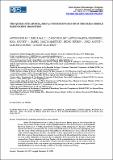Por favor, use este identificador para citar o enlazar a este item:
http://hdl.handle.net/10261/285246COMPARTIR / EXPORTAR:
 SHARE SHARE
 CORE
BASE CORE
BASE
|
|
| Visualizar otros formatos: MARC | Dublin Core | RDF | ORE | MODS | METS | DIDL | DATACITE | |

| Título: | The Quibas site (Murcia, Spain): new herbivores form the early-middle pleistocene transition |
Autor: | Rosas, Antonio ; Galli, Emilia; Fidalgo, Darío CSIC ORCID; García Tabernero, Antonio; Huguet, Rosa CSIC ORCID; García-Martínez, Daniel CSIC ORCID; Piñero, Pedro; Agustí, Jordi; Rico Barrio, Alba; Vallverdú, Josep CSIC ORCID | Fecha de publicación: | 3-nov-2022 | Editor: | Università degli Studi di Milano | Citación: | Rivista Italiana di Paleontologia e Stratigrafia 128: 745-772 (2022) | Resumen: | The Early Pleistocene site of Quibas, in Sierra de Quibas (Murcia, Spain) was discovered in 1994 and has since then provided abundant material of typical Epivillafranchian taxa. This biochron belongs to the Early-Middle Pleistocene transition (1.2 – 0.78 Ma), characterised by a change in orbital cyclicity from a 41 kyr cycle to 100 kyr that intensified the climate and culminated in the most important faunal turnover of the Pleistocene regarding large mammals. The Group of Palaeoanthropology of the National Museum of Natural Sciences (CSIC, Spain) and the Institut Català de Paleoecologia Humana i Evolució Social (IPHES-CERCA, Spain) carried out four field seasons from 2015 to 2018. Here we present the large herbivorous mammals recovered from the field, including the first citation of two taxa new to the locality: Stephanorhinus cf. etruscus and Bison cf. voigtstedtensis. We also provide the first description of previously mentioned taxa: Dama cf. vallonnetensis and Sus sp. Together with the remaining herbivores, the faunal community shows a strong European affinity with some regionalism. Compared with other Iberian localities, the site of Quibas stands out for the lack of hominin fossils or any evidence supporting their presence in the area, a peculiar scenario given that the Early-Middle Pleistocene transition broadly speaking sees the arrival of humans into Europe. | Versión del editor: | http://dx.doi.org/10.54103/2039-4942/16707 | URI: | http://hdl.handle.net/10261/285246 | DOI: | 10.54103/2039-4942/16707 | Identificadores: | doi: 10.54103/2039-4942/16707 issn: 2039-4942 |
| Aparece en las colecciones: | (MNCN) Artículos |
Ficheros en este ítem:
| Fichero | Descripción | Tamaño | Formato | |
|---|---|---|---|---|
| Rosas_A_The_Quibas.pdf | 3,88 MB | Adobe PDF |  Visualizar/Abrir |
CORE Recommender
SCOPUSTM
Citations
2
checked on 25-abr-2024
Page view(s)
36
checked on 29-abr-2024
Download(s)
125
checked on 29-abr-2024
Google ScholarTM
Check
Altmetric
Altmetric
Este item está licenciado bajo una Licencia Creative Commons

